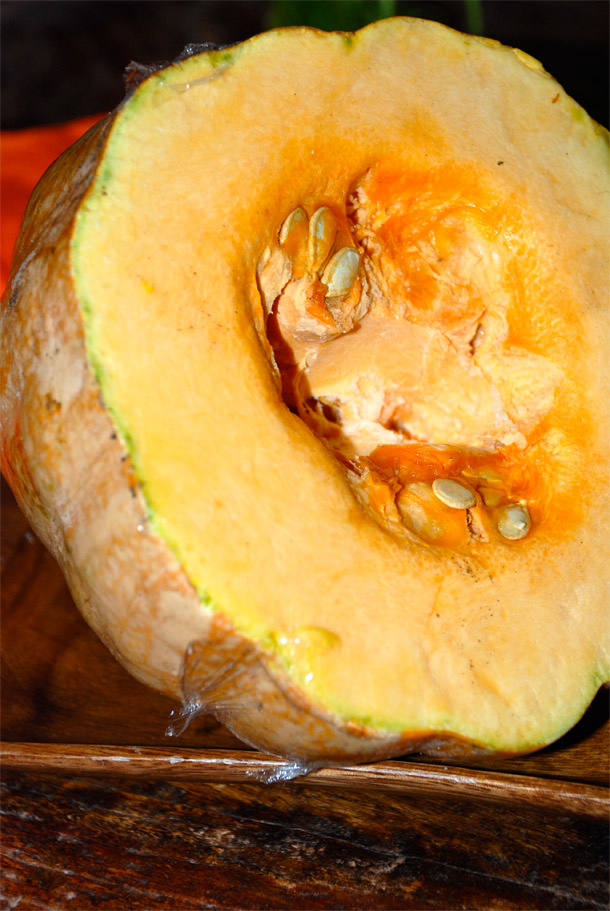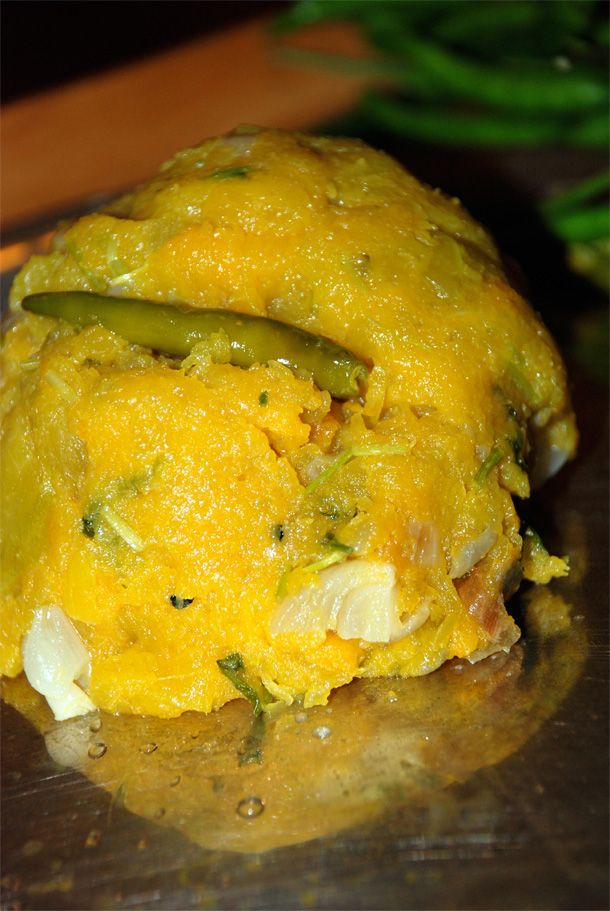
I didn’t grow up celebrating Halloween in India. Nor Valentine’s Day or Mother’s Day or Father’s Day for that matter. I don’t belong to the black and white generation either. But just like the tabs and the smartphones that have invaded our lives in a way that I don’t even remember the days when we didn’t have them, now I can’t even recall those days when pumpkin was remembered for the vegetable that it was, not a medium for creating strange artwork during Halloween in the name of art a.k.a pumpkin carving. Well, I am learning something new from the Z-Sisters every other day. When I tell them things like ‘when we were small, we never celebrated Halloween or played on tabs and X-boxes… ‘ the conversation takes a turn that I would have hated to hear as a child. Here I am, the modern day mum – technologically savvy, virtually available, active on social media, know each of my gadgets (and each remote control that monitors each gadget in the house) and there I am, wondering where today’s world is heading to – where marketing gimmicks blow up an ordinary day into a historic day screaming for epic celebration.

 The only unsavvy thing about me perhaps, is that I don’t play Candy Crush saga. But that is not because I cannot play the game, but because I am scared that I’ll be addicted to it. The fear stems from one incident in my childhood, when my parents had bought me an imported video game set from Hongkong market in Siliguri (a lot of imported goods, mostly from China and other Asian countries such as Nepal, Thailand, etc. used to be available in the days of pre-globalised India). I had played so much with the joystick (yes, those days the video games came with enormous joysticks that only pilots knew how to maneuver), that I found myself with a ‘locked’ fist for days!
The only unsavvy thing about me perhaps, is that I don’t play Candy Crush saga. But that is not because I cannot play the game, but because I am scared that I’ll be addicted to it. The fear stems from one incident in my childhood, when my parents had bought me an imported video game set from Hongkong market in Siliguri (a lot of imported goods, mostly from China and other Asian countries such as Nepal, Thailand, etc. used to be available in the days of pre-globalised India). I had played so much with the joystick (yes, those days the video games came with enormous joysticks that only pilots knew how to maneuver), that I found myself with a ‘locked’ fist for days! The bottom line – we didn’t associate Pumpkins with Halloween when we were kids. Quite naturally, pumpkins teared apart and carved into scary faces, is something that I am yet to reconcile with. Though I studied in a well known English medium school in Kolkata, the concept of Halloween was alien to us, as was Valentine’s Day. The only non-food association that I could come up with a pumpkin was that it could probably be transformed into a fairytale carriage, thanks to the copious amounts of books that we read since our childhood, starting from Russian folk tales to Grimm brothers – which molded us much later in life into the pseudo intellectuals that we as Bongs (the colloquial term for Bengalis), were always expected to be.
The bottom line – we didn’t associate Pumpkins with Halloween when we were kids. Quite naturally, pumpkins teared apart and carved into scary faces, is something that I am yet to reconcile with. Though I studied in a well known English medium school in Kolkata, the concept of Halloween was alien to us, as was Valentine’s Day. The only non-food association that I could come up with a pumpkin was that it could probably be transformed into a fairytale carriage, thanks to the copious amounts of books that we read since our childhood, starting from Russian folk tales to Grimm brothers – which molded us much later in life into the pseudo intellectuals that we as Bongs (the colloquial term for Bengalis), were always expected to be. Beautiful Pumpkins or Kumro bring to my memory lovely Kumror Chechki that accompanied perfectly puffed up fluffy Luchis {recipe here in my blog} on our Sunday breakfasts. If you ask what is Chechki, then the answer would be no short of a thesis. The style of preparation and the cooking categorise a Bengali vegetable dish into whether it would be called a Chechki or a Chokka or a Labda or otherwise. As if there isn’t enough complication in a Bengali’s life, a simple vegetable dish comes with thousand names! Rita, a reader asked me about these differences over a Labda picture (the Bengali ratatouille) that I had posted on my Facebook Page and I was contemplating whether I should delete my account just to avoid answering her. Bit I did answer her, which she exclaimed was an ‘amazing explanation’, giving me the courage to copy down an extract of it… ‘Rita, this is a huge subject of discussion – Chorchori, Chyachra, Labda, Chechki and Paanch-meshalir torkari, Ghyaat and Ghyonto! The differences lie in the cooking styles. Chorchori has got all mixed vegetables, cut in long strips (sometimes peel on), may or may not have fish bones and fish head, stir fried slightly with Paanch Phoron (the Bengali 5 spices); Chyachra is mainly with fish head, fish bones, fish oil and all the assortment of vegetables; Labda is when all the assorted vegetables are a bit overcooked – big leafy vegetables like Pui Shaak and Cabbage covers them all; Chechki is when the pieces of vegetables are left a bit chunky but overcooked; Ghonto would be the same but the vegetables are finely chopped and cooked in jhol, Ghyaat is exactly that ‘ghyaat‘ or punched!!! While there are fine boundaries lying between all of these, our Ma-Mashis knew exactly how to cut the vegetables for each of the dish and if you ask them for any explanation, there exists none!’
Beautiful Pumpkins or Kumro bring to my memory lovely Kumror Chechki that accompanied perfectly puffed up fluffy Luchis {recipe here in my blog} on our Sunday breakfasts. If you ask what is Chechki, then the answer would be no short of a thesis. The style of preparation and the cooking categorise a Bengali vegetable dish into whether it would be called a Chechki or a Chokka or a Labda or otherwise. As if there isn’t enough complication in a Bengali’s life, a simple vegetable dish comes with thousand names! Rita, a reader asked me about these differences over a Labda picture (the Bengali ratatouille) that I had posted on my Facebook Page and I was contemplating whether I should delete my account just to avoid answering her. Bit I did answer her, which she exclaimed was an ‘amazing explanation’, giving me the courage to copy down an extract of it… ‘Rita, this is a huge subject of discussion – Chorchori, Chyachra, Labda, Chechki and Paanch-meshalir torkari, Ghyaat and Ghyonto! The differences lie in the cooking styles. Chorchori has got all mixed vegetables, cut in long strips (sometimes peel on), may or may not have fish bones and fish head, stir fried slightly with Paanch Phoron (the Bengali 5 spices); Chyachra is mainly with fish head, fish bones, fish oil and all the assortment of vegetables; Labda is when all the assorted vegetables are a bit overcooked – big leafy vegetables like Pui Shaak and Cabbage covers them all; Chechki is when the pieces of vegetables are left a bit chunky but overcooked; Ghonto would be the same but the vegetables are finely chopped and cooked in jhol, Ghyaat is exactly that ‘ghyaat‘ or punched!!! While there are fine boundaries lying between all of these, our Ma-Mashis knew exactly how to cut the vegetables for each of the dish and if you ask them for any explanation, there exists none!’ Shorsher tel or Mustard Oil: A few things that cannot be substituted in most Bengali cooking is the use of Mustard Oil, specially in a Bengali fish dish {recipe of a traditional Bengali Mustard fish from the blog}. Without this, a Bengali fish is absolutely incomplete. The gravy that gathers once cooked in Mustard Oil is, then Bong certified! More so in a Bengali vegetarian dish, the aroma of the Panch Phoron or the Bengali 5 spices is complemented by the use of Mustard Oil. Getting the right Mustard Oil can be sometimes tricky on foreign shores. The Asian supermarkets do stock different types of Mustard Oil. Here in Dubai, even regular supermarkets like Spinneys, Choitram’s, Carrefour or Lulu Hypermarkets stock Mustard Oil but a few of the brands are taste very bland and flat. A small study into Mustard Oil {here…} probably will help in choosing the right Mustard Oil. It has to be really pungent, must be very deep in colour and have a strong Mustard smell. I have been using a brand that is called PRO (probably there are more brands around, but this is readily available. I remember using another brand called Tez while we were in Frankfurt. I had found this brand of Mustard Oil in Dubai too, but haven’t seen it around recently). Do look out for the term ‘Kachi Ghani‘ where the term refers to cold press extraction process of Mustard Oil, so that it may retain more oxidants and vitamins and needless to say, more pungency.
Shorsher tel or Mustard Oil: A few things that cannot be substituted in most Bengali cooking is the use of Mustard Oil, specially in a Bengali fish dish {recipe of a traditional Bengali Mustard fish from the blog}. Without this, a Bengali fish is absolutely incomplete. The gravy that gathers once cooked in Mustard Oil is, then Bong certified! More so in a Bengali vegetarian dish, the aroma of the Panch Phoron or the Bengali 5 spices is complemented by the use of Mustard Oil. Getting the right Mustard Oil can be sometimes tricky on foreign shores. The Asian supermarkets do stock different types of Mustard Oil. Here in Dubai, even regular supermarkets like Spinneys, Choitram’s, Carrefour or Lulu Hypermarkets stock Mustard Oil but a few of the brands are taste very bland and flat. A small study into Mustard Oil {here…} probably will help in choosing the right Mustard Oil. It has to be really pungent, must be very deep in colour and have a strong Mustard smell. I have been using a brand that is called PRO (probably there are more brands around, but this is readily available. I remember using another brand called Tez while we were in Frankfurt. I had found this brand of Mustard Oil in Dubai too, but haven’t seen it around recently). Do look out for the term ‘Kachi Ghani‘ where the term refers to cold press extraction process of Mustard Oil, so that it may retain more oxidants and vitamins and needless to say, more pungency.
Mashed Pumpkin Bengali Style or Kumro Bhaaté
Category – Vegetarian/Side Dish; Cuisine type – Bengali traditional
In Bengali, mashed steamed vegetables are called Bhaaté. The term literally means ‘in rice’ and must have originated because very often these vegetables were traditionally steamed in the same pan in which the rice has been cooked. Mashing these steamed vegetables – assorted vegetables or any particular vegetable along with a dash of Mustard Oil or Ghee (Indian clarified butter), the Bhaaté creates a delicious and a healthy accompaniment to plain white Rice and Daal (lentils). Bhaaté or Mashed Vegetables of Aloo/Potatoes, Kumro/Pumpkin, Ucche/Bitter Gourd etc are very popular. Add to the Mash a bit of chopped green chillis or onions, may be some fresh coriander leaves, a little dash of Mustard Oil and a bigger dash of Kasundi, a pungent mustard sauce used as a dipping (specially for another Bong favourite – Fish Fry) and a quasi side-dish is ready {here’s a recipe for another honourable Bhaaté from the blog – the Mashed Potato Bengali Style/ Aloo Bhaaté which have already floored my German friends}.
For the printable recipes →
Ingredients
500gm Pumpkin/Butternut Squash
1 medium sized Onion
1 Green Chilli, finely chopped if you want it spicy; slit in case you dont
1 tsp Black Cumin Seeds
1 tbsp Mustard Oil
1 tsp Kasundi paste
1 tsp roasted Cumin Powder
1 sprig fresh Coriander leaves, finely chopped
Method of Preparation
• Chop the Pumpkin into cubes, boil them (microwave/pressure cook) and mash them (not a puree)
• Heat oil in a wok, add the Black Cumin Seeds and let them splatter
• Add Onions, chopped Green Chillies, Coriander leaves, Salt and roasted Cumin Powder
• Add the mashed Pumpkin and let it cook in low seam until the mash thickens
• Turn off the fire, set aside and let it cool down, sprinkle more Coriander leaves, roasted Cumin Powder and add a dash of Kashundi

 Bhaaté is also called Makhaa (literal meaning – squashed or mixed) but I prefer to address by the former as the latter meaning connotes a lot of mess. Bhaatés make me absolutely nostalgic. I have got the strongest holiday memories of Bhaatés. When we would return from vacations and holidays and my Mum would be too tired to stir up anything in the kitchen, she would just steam a whole lot of vegetables and put the Daal/lentils (usually Masoor or Moong Daal) in a soft white cloth and tie it up and cook them all along with the Rice. Occasionally, she would put eggs into the crowd as well for boiling. And our lunch would be plain Rice, Daal, vegetables and the boiled eggs – all mashed up with a pinch of salt and dollops of butter or a generous spoonful of Ghee! The simplest recipe and the simplest meal – but absolutely divine.
Bhaaté is also called Makhaa (literal meaning – squashed or mixed) but I prefer to address by the former as the latter meaning connotes a lot of mess. Bhaatés make me absolutely nostalgic. I have got the strongest holiday memories of Bhaatés. When we would return from vacations and holidays and my Mum would be too tired to stir up anything in the kitchen, she would just steam a whole lot of vegetables and put the Daal/lentils (usually Masoor or Moong Daal) in a soft white cloth and tie it up and cook them all along with the Rice. Occasionally, she would put eggs into the crowd as well for boiling. And our lunch would be plain Rice, Daal, vegetables and the boiled eggs – all mashed up with a pinch of salt and dollops of butter or a generous spoonful of Ghee! The simplest recipe and the simplest meal – but absolutely divine.
 Pumpkins not only remind me of mashed Pumpkins but also the lovely batter fried Pumpkin fritters or Kumri (the picture above Big Z) that are perfect accompaniments of the lentil and rice dish, Khichuri, that a Bengali craves for, particularly when it rains. See the picture below? All the pumpkin discussion started from one Halloween special Brunch that we attended recently. I have to admit here that although I may cry foul for not understanding what Halloween is, I do let myself loose on any occasion that calls for celebration. I must say here that I have adapted to the changing times with great elan and celebrate Halloween or Valentine’s Day in the same manner that I would celebrate Christmas and get excited as much as I would while preparing an elaborate Bengali spread for Bijoya Dashami.
Pumpkins not only remind me of mashed Pumpkins but also the lovely batter fried Pumpkin fritters or Kumri (the picture above Big Z) that are perfect accompaniments of the lentil and rice dish, Khichuri, that a Bengali craves for, particularly when it rains. See the picture below? All the pumpkin discussion started from one Halloween special Brunch that we attended recently. I have to admit here that although I may cry foul for not understanding what Halloween is, I do let myself loose on any occasion that calls for celebration. I must say here that I have adapted to the changing times with great elan and celebrate Halloween or Valentine’s Day in the same manner that I would celebrate Christmas and get excited as much as I would while preparing an elaborate Bengali spread for Bijoya Dashami.
Unblogging it all… Ishita
Disclaimer: Please note that this is not a sponsored blog and all the opinions and views stated here are my own and are independent. The brunch at The Address Marina costs Dhs 220/person including soft beverages; Children six years and under enjoy complimentary meals and half the price for seven to 12 years. This month the Generation Creation brunch at Mazina organised sushi making while next month it’s going to be ginger bread making. While you enjoy reading the posts with lot of visuals, please do not use any material from this post. You can see more pictures of my travel and food journey here.


True Ishita! Difficult to relate to Pumpkins and Halloween!! It is not just about you being modern and hand in glove with the boons of modernism. It is about that uncanny phrase ‘generation gap’ that every generation of parents is subjected too and so would be our kids when they become parents. Although interestingly this generation gap seems to melt away with the penultimate set of parents, the grand parents!! So, it would be worth waiting for the Z 2.0 version of the Z sisters to come up (whenever that happens) to comfort your bewilderments.
What surprises me more is not the Pumpkin- Halloween relationship nor the Valentine Day nor the so many Father/Mother/Brother/sister and you- name -it days of which we never heard in our growing years, but that how these concepts have gained an international flavor and despite being a host to one fifth of the world’s population, we could not similarly promote our Raksha Bandhan day, Guru Purnima Day or the many festivals symbolising a host of niceties that bond human kind….
Thanks for bringing back the nostalgia of Kumro Chechki and Luchi. I guess I know now what would be on the Breakfast table coming weekend.
LikeLike
Hi Gopa, thank you so much for sharing your thoughts. You have highlighted so many points, but your suggestion – ‘to wait for Z 2.0 version of the Z sisters to come up (whenever that happens) to comfort your bewilderment’ is making me roll on the floor in laughter. How true that the generation gap melts with grandparents. Do think of me when you eat the Kumror Chechki with Luchi over the weekend – I surely am too lazy to make for ourselves!
LikeLike
Hey Ishita,
We actually cook pumpkin with methi leaves and channa dal once in a way…Infact was made just a couple of days ago…This is an interesting recipe almost like a bharta…Will certainly try this as a variation next time:))
LikeLike
Hi Shy, that’s an interesting twist. Channa Dal like a tadka (like in South Indian dosa filler)? This is a bhaaté, that is, steamed in rice. In Bangladesh, I believe there’s a long list of bhartas they make – getting hold of them would be quite interesting.
LikeLike
Great post Ishita ….. I did not know what a Kumro Bhate was before i read this …. I’ll surely try this …..
LikeLike
Thank you Elora…. it’s not a very popular dish in any case. A very basic comfort food made at home when Mummy has bad hair days!
LikeLike
Rats! My neighbours (in Spain) gave me some pumpkin (calabaca) and after I had made some soup (OK but nothing special) and a vile fried dish, I ended up giving the rest to the cockerel. If only I had seen your excellent sounding recipe. (found your blog via Madhu’s post about the google ad and partition)
LikeLike
I’m glad that you hopped in here. That’s a lucky cockerel, I must say 🙂
LikeLike
Hi Ishita, lovely blog and beautiful pictures captured over span of different things! I am loving your blog and recipes. Have a wonderful holidays !
LikeLike
Thank you so very much! Hope you drop in again… have a fabulous 2014 🙂
LikeLike
Looks really awesome!
LikeLike
Thank you Shil… tastes awesome too!
LikeLike